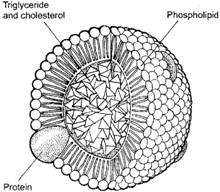Cholesterol Metabolism
Lipid and Lipoprotein Metabolism (Rosensen, 2009)
Lipids = cholesterol and triglyceride - are insoluble in plasma and are transported in lipoproteins.
Functions = energy utilization, steroid hormone production, bile acid production, lipid deposition.
Lipoprotein consists of esterified and unesterified cholesterol, triglycerides, phospholipids and apolipoproteins. The proteins function as cofactors and ligands for receptors.

Major lipoproteins include:
- Chylomicrons - large particles that carry dietary lipid
- Very low density lipoprotein - carry endogenous triglyceride and some cholesterol
- Intermediate density lipoprotein - carry cholesterol esters and triglycerides
- Low density lipoprotein - carry cholesterol esters
- High density lipoprotein - carry cholesterol esters
Exogenous pathway for lipid metabolism:
- Dietary cholesterol and fatty acids are absorbed.
- Triglycerides are formed in the intestinal cell from free fatty acids and glycerol and cholesterol is esterified.
- Triglycerides and cholesterol combine to form chylomicrons.
- Chylomicrons enter the circulation and travel to peripheral sites.
- In peripheral tissues, free fatty acids are released from the chylomicrons to be used as energy, converted to triglyceride or stored in adipose.
- Remnants are used in the formation of HDL.
Endogenous pathway for lipid metabolism:
- VLDL is formed in the liver from triglycerides and cholesterol esters.
- These can be hydrolyzed by lipoprotein lipase to form IDL or VLDL remnants.
- VLDL remnants are cleared from the circulation or incorporated into LDL.
- LDL particles contain a core of cholesterol esters and a smaller amount of triglyceride.
- LDL is internalized by hepatic and nonhepatic tissues.
- In the liver, LDL is converted into bile acids and secreted into the intestines.
- In non hepatic tissues, LDL is used in hormone production, cell membrane synthesis, or stored.
- LDL is also taken up by macrophages and other cells which can lead to excess accumulation and the formation of foam cells which are important in plaque formation.
What does HDL do?
HDL is a small particle composed of phospholipid and apolipoproteins and produced in hepatic and intestinal cells.
Why is HDL good?
Incidence of coronary heart disease events in a normal population is inversely related to the serum HDL-cholesterol concentration - low levels carry an increased coronary risk
HDL is thought to be anti-atherogenic and high HDL levels are cardioprotective.
This effect may be mediated by reverse cholesterol transport, a process whereby excess cholesterol in cells and in atherosclerotic plaques is removed and transported back to the liver.
Risk for myocardial infarction increases by about 25 percent for every 5 mg/dL decrement in serum HDL-cholesterol below median values for men and women.
Low HDL-cholesterol is a component of the metabolic syndrome that is characterized by obesity, insulin resistance, dyslipidemia, and hypertension
Patients considered high risk for cardiovascular disease based on HDL levels include:
- Patients with HDL less than 40 mg/dL
- Patients with the metabolic syndrome - gender adjusted HDL-cholesterol levels of less than 40 mg/dL in men and 50 mg/dL in women.
Exercise, weight loss (in overweight subjects), smoking cessation, and changes in diet (specifically substitution of monounsaturated for saturated fatty acids) all can raise HDL-cholesterol.
Medical treatment for low HDL includes niacin and fibrates.